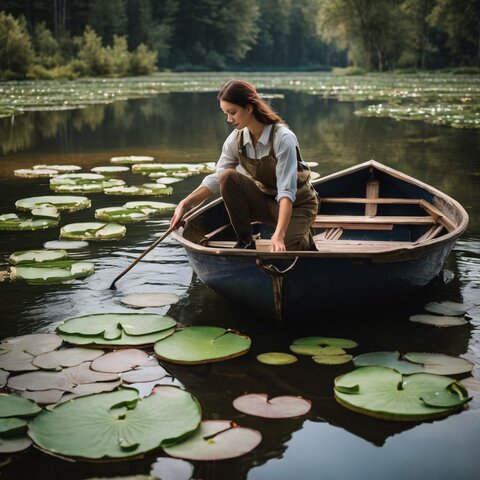
How to Get Rid of Lily Pads
Discover how to get rid of lily pads that are blocking the view of clear water and disrupting the balance of your aquatic ecosystem.
These floating beauties often become invasive, spreading quickly across calm waters.
Our blog offers effective strategies to tackle this issue, ensuring a healthy pond environment for all its inhabitants.
Dive in for solutions that work!
Identification of Water Lily Pads
Knowing what you're dealing with is the first step in solving any problem. Water lilies have distinctive features that set them apart from other aquatic plants.

Look for broad, floating leaves that often have a split or notch at one side.
These can be several inches across and are usually a vibrant green color.
The flowers of water lilies also help with identification.
They sit pretty on the water surface and bloom into colors like white, pink, yellow, or purple depending on the species.
The scent is lovely and sweet, which makes them easy to spot during blooming season.
Remember these characteristics when you prepare to clear out unwanted lily pads from your pond or lake.
Why Remove Lily Pads?
While lily pads add beauty and habitat in ponds and lakes, excessive growth can disrupt aquatic ecosystems by covering the water's surface.

Excessive coverage by lily pads can limit sunlight penetration, affecting underwater plants' ability to photosynthesize and produce oxygen, which is crucial for aquatic life.
While thick lily pad growth offers habitat for a variety of wildlife, it can also support mosquitoes, necessitating balanced management. Removing these aquatic weeds helps control mosquito populations.
A clear pond allows fish to get enough oxygen and keeps the water healthy for wildlife.
Without lily pads taking up space, more diverse plant life can flourish too.
People also get rid of lily pads for easier fishing and boating. Mats of these plants make it hard to move boats through the water.
They interfere with fishing lines as well.
Methods of Lily Pad Removal

Discover the various strategies for clearing out unwanted lily pads in your pond, from hands-on tactics to more sophisticated techniques, ensuring a serene and balanced aquatic habitat.
Physical Removal by Hand
Getting rid of water lilies can be tough. Physical removal by hand is a great way to tackle this problem.
- Wear gloves to protect your hands.
- Use a boat or wade into the water if needed.
- Grab the base of the lily pad's stem near the root.
- Pull firmly to remove the entire plant, including roots.
- Repeat this process for each lily pad you want to remove.
- Consider tools like the Lily Pad Ripper for easier removal.
- Consider using specialized aquatic vegetation management tools for more stubborn plants.
- Pile up the removed lilies on land away from the water's edge.
- Let them dry out before disposing of them properly.
- Keep an eye out for new growth and remove it early.
Raking or Cutting
Raking and cutting are popular methods to get rid of lily pads. These tactics work well for controlling the spread in ponds and lakes.
Here’s how you can use them effectively:
- Choose your tools wisely. For raking, get a long - handled pond rake with strong teeth that can grip the stems and roots.
- Start at the edge of the pond. Rake towards the center to gather lily pads into a pile.
- Pull hard on the rake handle to rip the pads from their roots which will prevent immediate regrowth.
- Cut stubborn lily pads using tools like the Lily Pad Ripper or Aquatic Vegetation Groomer.
- Slice through stems below water level to ensure they don't float away.
- Collect all removed plant material from the water to keep your pond clean.
- Dispose of lily pad waste properly, far from any water bodies to avoid them taking root elsewhere.
- Note: Pay attention to local environmental regulations before starting removal processes, as some lily pad species may be protected or beneficial for local ecosystems.
Shading
Shading blocks sunlight from reaching lily pads, slowing their growth. Use dark plastic sheets or pond dyes to cover the water surface.
This method can help control the spread of these aquatic plants by cutting off the light they need to thrive.
Place the materials carefully across the water without harming other wildlife in your pond.
Over time, shading will make it tough for lily pads to carry out photosynthesis, causing them to weaken and die off.
It's a safe approach that doesn't rely on chemicals and preserves your pond's health for fish and frogs.
Using Herbicides for Lily Pad Control
Herbicides can tackle tough lily pad problems when used responsibly. Select products specifically approved for aquatic use, such as those containing 2,4-D Selective Weed Killer or Glyphosate 5.4 designed for water bodies, to ensure environmental safety.

Measure your pond before buying herbicides to get the right amount.
Use these chemicals when lily pads are growing strong, usually from late summer until the first cold snap.
Add a surfactant to your spray mix to break down the waxy layer on lily pads; it lets the herbicide soak in better.
Choose either glyphosate-based or imazapyr-based products based on how stubborn those water lilies are.
It's crucial to comply with local environmental regulations when using herbicides in waterways to ensure both legal adherence and ecological safety.
It's important to follow label directions and local regulations explicitly. Overuse or improper application of herbicides can lead to environmental damage and harm aquatic life.
Automated Control of Water Lilies
Automated control of water lilies offers a convenient solution for maintaining a weed-free lake bottom without continuous labor.
The Lake Groomer and Aquatic Mower are automated tools designed to dislodge and prevent the growth of water lilies.
These machines work by moving across the pond bed, agitating the soil, and disrupting root systems.
The Eco Harvester pulls up water lilies from the roots for reuse as mulch or animal feed.
This machine is eco-friendly because it removes plants whole, leaving no debris behind.
Using such devices can save time and effort while keeping ponds clean and healthy.
Automated control ensures that areas prone to invasive species stay manageable over time without harming aquatic life or causing environmental impact.
Prevention of Water Lily Reinfestation
Stop water lilies from coming back by using Vision Pond Dye. It keeps the sun from helping new seeds grow.
Keep your pond clean and free of dead plants, too. This stops more seeds from settling at the bottom.
Use aquatic herbicides carefully after lilies flower but before they drop new seeds.
Choose the right time to treat them with chemicals like 2,4-D or Glyphosate 5.4. These herbicides work best then and help keep lilies away longer.
Control animals that spread water lily seeds such as ducks and muskrats. Put up barriers or scare devices if you need to keep these animals out of your pond area.
Stay on top of things! Check your pond often for any signs of new water lily growth so you can deal with it quickly.
The Role of Continuous Pond Aeration
Continuous pond aeration increases oxygen levels and water circulation, which can indirectly impact water lilies by promoting healthier aquatic ecosystems. However, aeration alone may not significantly reduce established lily pad populations but can support overall pond health.
It takes away their perfect still water and slows down their growth.
Aeration also helps by cutting down on the food that water lilies need to spread.
Oxygen from aerators is good for helpful bacteria that live in the pond.
These tiny workers help keep the water clean and cut back on muck where lilies might grow. With less muck, there's not much room for new lily pads to start growing.
So, keeping your pond full of air keeps it healthy which is bad news for those pesky lily pads!
Choosing the Right Lily Pad Removal Method for Your Pond or Lake
Selecting the optimal strategy for eradicating lily pads hinges on understanding your specific aquatic environment.
Dive into the nuances of various removal techniques to ensure a balanced ecosystem and achieve lasting results in your pond or lake management efforts.
Considering the Size of the Water Body
Big ponds and lakes need different methods than small ones. Calculate the water body size to know how much herbicide to use.
For large areas, automated control helps keep the bottom free of weeds without constant work.
Smaller ponds might just need hand removal or cutting.
Herbicides like glyphosate and diquat should match the pond size and lily area.
Always read labels to use the right amount for your water body's size. This stops too much chemical use and protects lake ecology.
Pond dye also works by blocking sunlight, preventing new lily pads from growing.
Assessing the Density of the Lily Pad Infestation
Once you know the size of your pond or lake, it's time to check how thick the lily pads are.
Look at how much of the water surface is covered with lilies. A few scattered pads won't need the same approach as a pond blanketed in green.
Counting patches or using a grid system can help figure out how many plants you have.
Heavy clusters mean more work and might call for strong methods like herbicide control or mechanical removal.
Fewer pads could be easier to handle with hand-pulling or cutting tools.
Always think about what’s living in your pond too.
Fish, frogs, and insects all react differently to changes in their home, so choose a treatment that keeps them safe while getting rid of unwanted lilies.
Evaluating the Impact on Aquatic Life
Lily pads offer homes and food for fish, frogs, and insects.
They die and break down, feeding even more creatures in the pond. Removing lily pads must be done carefully to protect these animals.
Use methods that don't harm them or upset their homes.
Many wildlife eat parts of water lilies like leaves and seeds.
Think about this before choosing how to get rid of the plants. If you pick a method like herbicides with 2,4-D, it could hurt fish or bugs living in the water.
Find ways to remove lily pads that keep the balance for all pond life.
FAQs
Can I use a chemical to remove lily pads from my pond?
When using glyphosate herbicides, ensure the product is labeled for aquatic environments to prevent harm to aquatic life and maintain water quality.
Are there natural ways to get rid of lily pads without chemicals?
While nutria can consume water lilies, introducing or relying on non-native species like nutria for control is not recommended due to their potential to cause ecological imbalance. Instead, consider manual removal or seek advice on sustainable control methods. Also, physically removing the plants with tools like a razor or cutting device works too.
Will wind and weather naturally take care of the lily pads in my pond?
Wind alone might not be enough to get rid of lily pads because they have strong roots. Mechanical removal or chemical treatment is often necessary.
What should I know about using biological control for yellow water lilies?
Biological control methods can vary based on the local ecosystem and regulatory approval. Consult with environmental specialists to identify native predators or control agents suitable for your area.
Conclusion
Choose the right method when learning how to get rid of lily pads to help clear up your pond. Consider the size and life within your water before deciding.
Use tools, herbicides, or even shading to clear them out.
Regardless of the method chosen, always prioritize the health and sustainability of your aquatic ecosystem, ensuring actions taken today preserve the environment for future generations
Keep your pond healthy with regular upkeep and aeration. Say goodbye to unwelcome lily pads and hello to a beautiful, balanced aquatic space!
